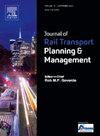加强铁路营运安全:危险信号的定量风险评估
IF 2.7
Q3 TRANSPORTATION
Journal of Rail Transport Planning & Management
Pub Date : 2025-01-13
DOI:10.1016/j.jrtpm.2025.100504
引用次数: 0
摘要
未经授权的“危险信号通过”(spad)是葡萄牙铁路事故的常见前兆。过去发生的重大事件突出表明,有必要评估特别防御计划带来的风险。本研究提出了葡萄牙spad的定量风险评估作为决策支持工具,利用三步程序和2016年至2021年的数据。第一步是利用广义线性模型(如二项回归和泊松回归)对SPAD频率进行统计建模,包括时空和操作因素。二项模型表现出最佳的拟合优度统计。第二步是对spad的严重程度进行统计建模,并基于事件相关数据创建严重程度预测模型,比较序数模型和多项式模型的预测性能。最后,通过估计一年的成本大小来评估风险。此外,还评估了列车自动保护系统对SPAD风险的影响。研究结果表明,全面运作的ATP系统可以进一步降低19%的SPAD风险。这项研究强调了考虑SPAD风险对安全和高效铁路运营的重要性。这种风险评估的结果可以支持决策者确定预防和缓解措施的优先次序,以提高铁路运营安全。本文章由计算机程序翻译,如有差异,请以英文原文为准。
Enhancing railway operational safety: A quantitative risk assessment of signals passed at danger
Unauthorized ‘Signals Passed At Danger’ (SPADs) are common accident precursors in the Portuguese railways. Critical events in the past highlight the need to assess the risk posed by SPADs. This study proposes a quantitative risk assessment of SPADs in Portugal as a decision support tool, utilizing a three-step procedure, and data from 2016 to 2021. The first step involves statistically modeling the SPAD frequency, including the spatio-temporal and operational factors using Generalized Linear Models, such as Binomial and Poisson regressions. The Binomial models exhibit the best goodness-of-fit statistics. The second step involves statistically modeling the severity of SPADs and creating a severity prediction model based on incident-related data, with Ordinal and Multinomial models compared for prediction performance. Finally, the risk is assessed by estimating the cost magnitude for one year. Additionally, the influence of the Automatic Train Protection (ATP) system on SPAD risk is evaluated. The findings suggest that a fully operational ATP system could further reduce SPAD risk by 19%. This study highlights the importance of considering SPAD risk for safe and efficient railway operations. The results of this risk assessment can support decision-makers in prioritizing prevention and mitigation measures to improve railway operational safety.
求助全文
通过发布文献求助,成功后即可免费获取论文全文。
去求助
来源期刊

Journal of Rail Transport Planning & Management
TRANSPORTATION-
CiteScore
7.10
自引率
8.10%
发文量
41
 求助内容:
求助内容: 应助结果提醒方式:
应助结果提醒方式:


